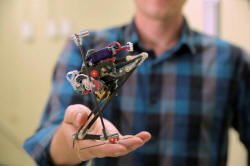|
Little African primate's
talents inspire leaping robot
 Send a link to a friend
Send a link to a friend
 [December 07, 2016]
By Will Dunham [December 07, 2016]
By Will Dunham
WASHINGTON
(Reuters) - Inspired by the remarkable jumping ability of an African
primate called a galago, scientists have fashioned a small robot with
unique leaping capabilities they hope can someday be used in tricky
search-and-rescue situations.
The scientists said on Tuesday they had built a robot, dubbed Salto,
with vertical jumping agility like no other machine, able to leap into
the air and then spring off a wall, or perform multiple vertical jumps
consecutively.
In designing mobile robots, researchers sometimes mimic the way animals
move. For example, some robots slither over terrain like a snake. In
this case, the researchers sought to create a robot that might need to
hurdle impediments as it traverses difficult terrain like the rubble of
a building wrecked by an earthquake.
To design Salto, short for "saltatorial locomotion on terrain
obstacles," the University of California, Berkeley, researchers sought
inspiration from one of the animal kingdom's best leapers.
The galago, or bushbaby, is a relatively small, typically night-active
and tree-dwelling primate. It is an agile leaper and can hop high in the
air on two legs while on the ground. The goal was to build a robot
better at leaping than any other.

"We looked to biology for inspiration because it's fair to say that
animals can outclass any robot when it comes to jumping," said robotics
researcher Duncan Haldane, who led the study published in the journal
Science Robotics.
"Our goal was to have a search-and-rescue robot small enough to not
disturb the rubble further (and) move quickly across the many kinds of
rubble produced by collapsed buildings."
The galago jumps so well because it stores energy in its tendons when it
is in a crouched position and can then spring into the air. The
researchers adapted that into Salto by using a motorized, spring-loaded
leg mechanism that lets the robot get into the same type of crouched
position.
[to top of second column] |

A new robot dubbed Salto, by scientists, for its vertical jumping
agility, is shown in Berkeley, California, U.S. November 17, 2016.
Courtesy of Stephen McNally/University of California/Handout via
Reuters

Salto
weighs 3.5 ounces (100 grams), is about 10 inches (26 cm) tall and can jump 3.3
feet (1 meter) high. It achieves 78 percent of the galago's vertical jumping
prowess.
"We're particularly interested these days in seeing if we can not just match but
exceed the performance of animals," said UC-Berkeley electrical engineering and
computer sciences professor Ronald Fearing, who heads the lab where Salto was
developed.
"The more we understand about how animals move and how to use the available
engineering technologies, the closer we can get to that point."
(Reporting by Will Dunham; Editing by Peter Cooney)
[© 2016 Thomson Reuters. All rights
reserved.] Copyright 2016 Reuters. All rights reserved. This material may not be published,
broadcast, rewritten or redistributed.
 |